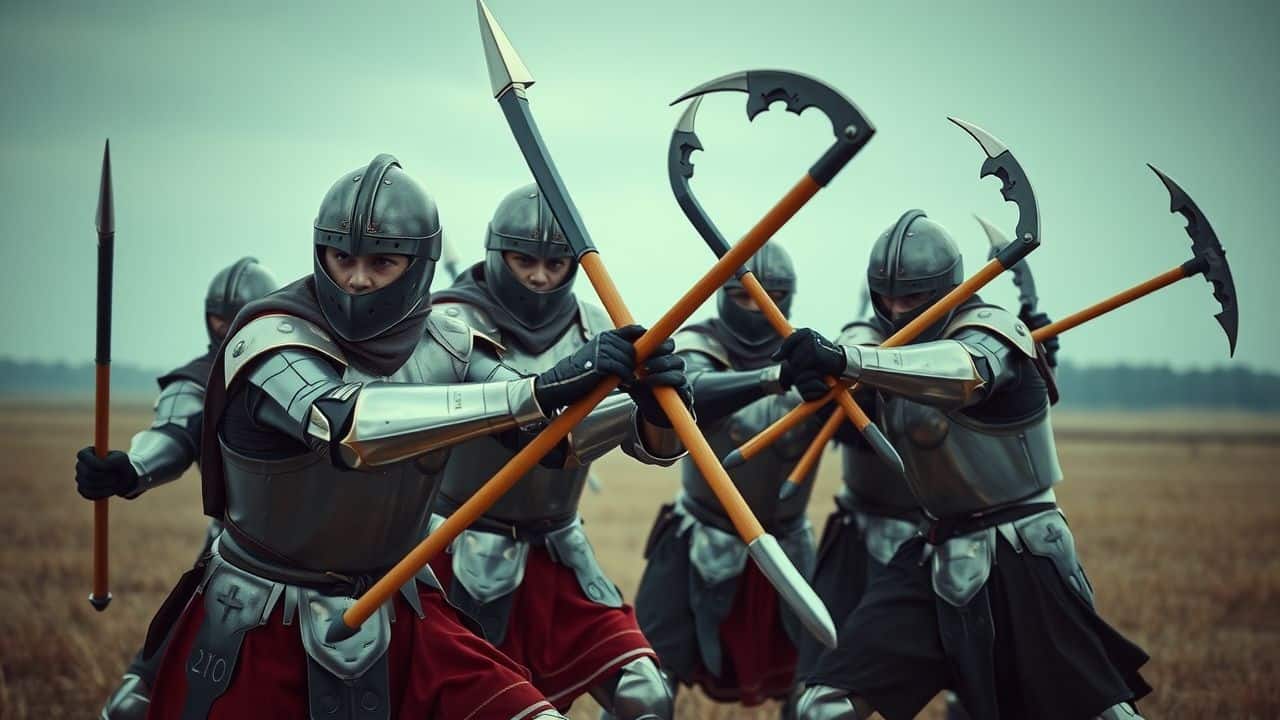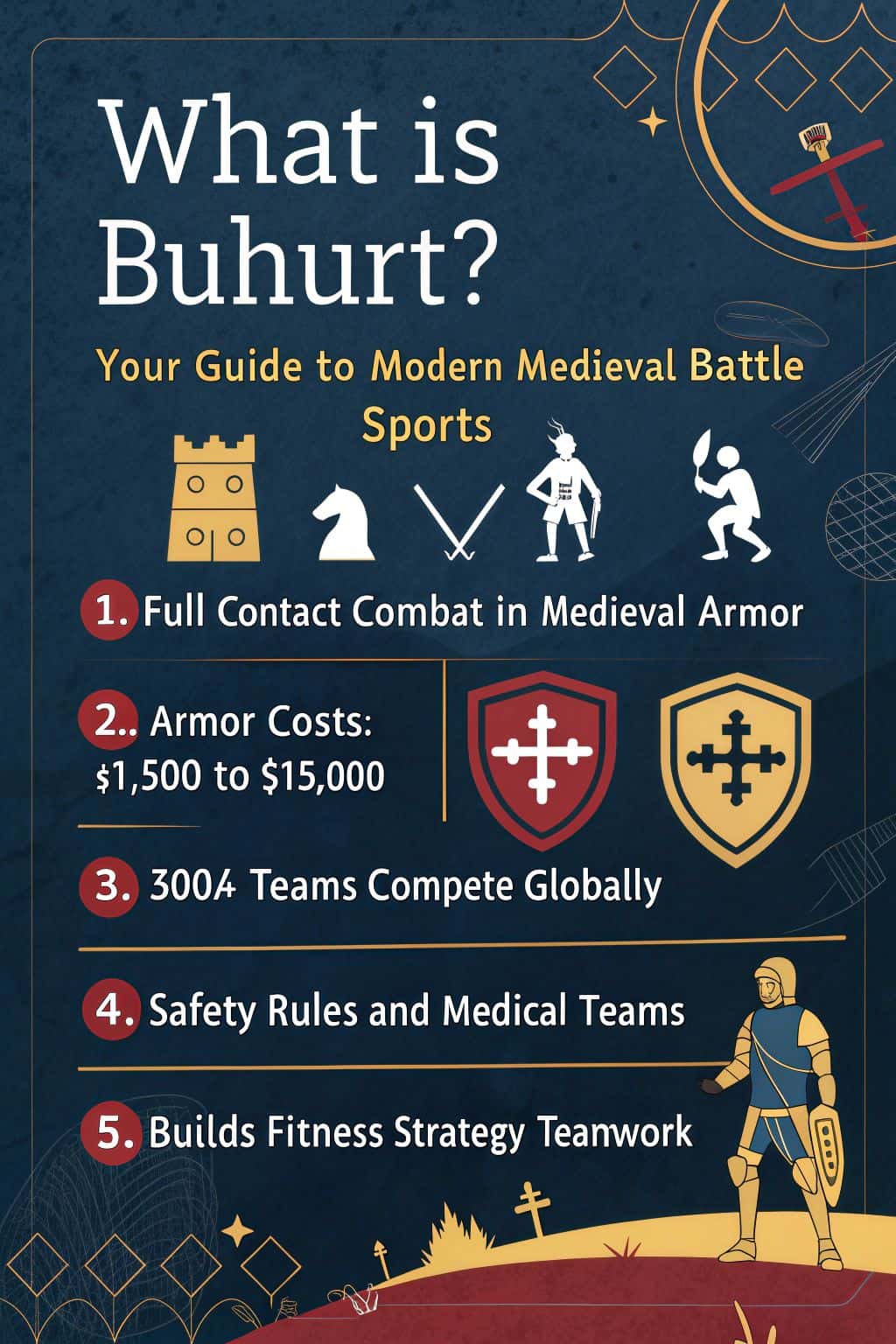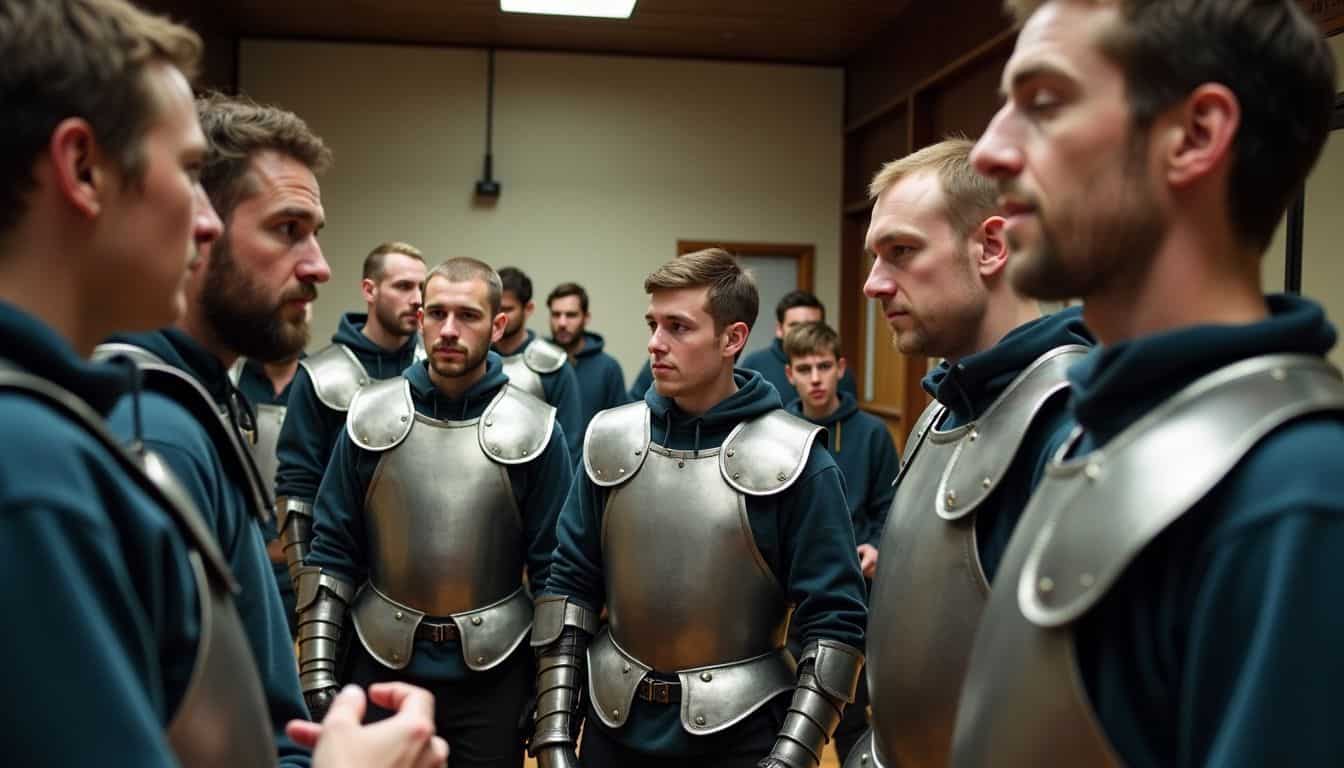Ever wondered about those armored warriors clashing with steel weapons at your local park? Buhurt, a full-contact medieval combat sport, puts fighters in up to 100 pounds of armor as they battle with blunted weapons.
This guide will answer “what is buhurt” and show you how to join this thrilling combat sport that mixes history with modern athletics. Get ready to discover a sport where knights still rule the battlefield.
Key Takeaways
Buhurt is a full-contact medieval combat sport where fighters wear up to 100 pounds of armor and use blunted steel weapons. The sport started in the 13th century and was revived in Russia and Ukraine during the 1990s.
Complete armor sets cost between $1,500 to $15,000. Fighters must follow strict safety rules set by the International Medieval Combat Federation. All weapons need safety checks before battles.
Over 500 teams now compete across 42 countries in group melees and one-on-one duels. Fighters lose if three points of their armor touch the ground. Local clubs offer training and gear support to newcomers.
Matches last 3 minutes per round. Medical teams must be present at all events. Fighters can’t strike forbidden areas like the spine or back of knees.
The sport builds physical fitness through intense training. Most fighters train 5 days weekly. Teams must work together and use smart battle plans to win fights.
Table of Contents
What is Buhurt?

Now that you know about medieval combat sports, let’s explore the thrilling world of Buhurt. This full-contact battle sport combines ancient combat skills with modern safety rules.
Fighters wear heavy armor and use blunt steel weapons to knock down their opponents. The sport traces its roots back to the 13th century, where knights used it to sharpen their combat skills and entertain crowds.
Buhurt turns average people into modern-day knights, fighting with honor and steel.
The International Medieval Combat Federation sets strict rules for this martial art. Teams clash in group melees or one-on-one duels using swords, shields, and polearms. Fighters score points by grounding their rivals or winning structured fights.
The sport welcomes both men and women, with local clubs offering training and gear to newcomers. Unlike stage combat, Buhurt demands real physical contact and fighting skill. Many participants say the rush of wearing armor and swinging a sword beats any video game experience.
The Origins of Buhurt

Medieval knights started Buhurt in the 13th century as a way to stay battle-ready. These brave warriors needed real combat practice to keep their skills sharp. They would gather in open fields, dressed in full armor, and clash with blunted weapons.
Local crowds loved these exciting displays of martial arts skill. Knights showed off their mastery of long swords and poleaxes while testing new fighting methods. The practice helped them perfect their grappling moves and weapon techniques in a safer setting than actual warfare.

Russia and Ukraine breathed new life into this ancient sport during the 1990s. Fighting enthusiasts wanted to bring back the thrill of medieval combat with modern safety rules. They created special titanium armor that looked like historical pieces but offered better protection.
Teams started forming in cities across Eastern Europe, mixing traditional swordplay with new combat styles. Local clubs popped up where members could train in full-contact team sport battles.
The sport caught on fast, spreading from small practice sessions to huge international tournaments. Modern fighters now use a mix of historical weapons like halberds while following strict safety guidelines.
Essential Elements of Buhurt

Buhurt fighters need a full set of historical armor and blunted steel weapons to hit, kick, and grapple their way through battles – want to learn what makes this medieval combat sport tick? Keep reading!
Historical Armor

Steel armor stands as the backbone of modern Buhurt fighting. Fighters suit up in heavy-duty protective gear that tips the scales at 100 pounds. This historical-inspired gear includes vital pieces like the neck armor and spine protection.
A fighter’s brigandine must fit perfectly to guard against the fierce strikes of blades and spears in combat.
Your armor is your castle – it keeps you safe while you’re getting pummeled by steel.
Modern Buhurt armor mixes old-world style with new-age safety features. Fighters can pick between steel or titanium pieces, with complete sets costing anywhere from $1,500 to $15,000.
Each piece needs regular maintenance to stay battle-ready. Despite all this protection, fighters still risk getting hurt during intense matches, making proper armor fit and upkeep crucial for survival in the ring.
Blunted Steel Weapons

Blunted weapons pack a serious punch in Buhurt battles. Fighters use swords, axes, and maces made from real steel, but with dulled edges for safety. These weapons let fighters experience the thrill of medieval combat without the deadly results.
Much like muay-thai fighters who use elbows in combat, Buhurt athletes must master proper striking techniques.
Modern blacksmiths craft these battle-ready tools with precise specs. The weapons follow strict rules about weight, shape, and edge thickness. Each piece goes through tough safety checks before a fight.
Think of it as grounding and pounding with medieval flair. The blunt edges prevent cuts, but the solid steel construction still delivers powerful blows that test armor and skill.
Rules and Regulations in Buhurt

Buhurt follows strict combat rules that focus on fighter safety and fair play, and you’ll need to check your local inbox for the latest updates from your regional marshal about safety standards and combat guidelines.
Safety Standards

Modern medieval combat demands strict safety rules to protect fighters. Safety standards make this full-contact sport possible while keeping warriors safe in their 100-pound armor suits.
Combat Guidelines

Combat guidelines in Buhurt follow strict rules to keep fighters safe while having fun. These rules mix old-school fighting spirit with modern safety standards.
- Fighters must stay on their feet during battles. A match ends if three points of your armor touch the ground.
- Direct hits to forbidden areas like the spine, back of knees, and feet are not allowed.
- Each fighter needs full metal armor that matches historical designs from 1200-1699 CE.
- Strikes must land with the weapon’s blade or striking edge, not the point or pommel.
- Grappling moves like throws and trips are okay, but no punching or kicking.
- Fighters score points through clean hits with proper weapons to valid target areas.
- Battle rounds last 3 minutes with short breaks between rounds for rest and gear checks.
- Teams must have equal numbers of fighters on each side during group battles.
- Refs can stop fights if they spot broken gear or unsafe fighting styles.
- Fighters need to show good sportsmanship and follow ref calls right away.
- All weapons must pass safety checks before each event to make sure they’re blunt enough.
- Medical staff must be present during all official matches and practice sessions.
- Fighters can tap out at any time if they feel unsafe or need a break.
Types of Buhurt Battles

From epic group battles to intense one-on-one matches, Buhurt offers fighters a chance to test their skills in different combat formats, and you’ll want to stick around to learn more about these heart-pounding battle types.
Group Melees
Group melees stand as the heart-pounding core of Buhurt combat. Teams of 2 to 150 armored fighters clash in an epic battle until one side remains standing. Fighters must stay on their feet, as touching the ground with three points of armor means elimination.
The battlefield buzzes with energy as warriors push, pull, and strike with blunted weapons.
In the heat of battle, every fighter knows: three points down, and you’re out!
Skilled marshals keep watch over these intense battles like clockwork masters of Greenwich Mean Time. They spot rule breaks and hand out warnings to keep everyone safe. Fighters use smart tactics like leg sweeps and group formations to knock opponents down.
These battles build strong bonds between teammates who must work together to win. The clash of steel and thunder of bodies hitting the ground creates an unforgettable spectacle that draws crowds worldwide.
Duel Competitions
Duel battles stand as the heart-pounding core of Buhurt competitions. Steel clashes against steel as two fighters face off in best-of-three rounds, scored by clean strikes landed on their opponent.
The International Medieval Combat Federation keeps these matches fair with strict rules. Each fighter must sport historically accurate armor from head to toe, making the battles look like they jumped right out of a medieval history book.
Modern-day knights need more than just brute force to win these duels. Smart fighters mix power moves with quick footwork to score points. I’ve watched countless matches where the smaller fighter outsmarts their bigger opponent through clever tactics.
The whole scene feels like a giant cookie jar of medieval combat, packed with thrilling moments and epic clashes. The best part? These duels create lasting friendships among fighters who share a passion for historical combat sports.
The Growing Buhurt Community

Buhurt has exploded in popularity, with over 500 teams now battling it out in epic tournaments across 42 countries – and like sharing cookies after a hard fight, this community keeps getting sweeter!
International Events
Modern knights clash steel at grand tournaments across the globe. The International Medieval Combat Federation hosts world championships where fighters test their metal against top warriors.
These battles bring together people who love nerd activities from many nations, creating an amazing spectacle of combat skills.
Finland stands out in the international scene with its famous Häme Cup. This exciting event takes place during the Häme Medieval Fair each August. Fighters and fans travel far to join the action, share battle stories, and make new friends.
The spirit of fellowship runs strong at these gatherings, where cookies and combat mix perfectly in the festival atmosphere.
Local Clubs and Teams
Buhurt clubs pop up in cities across the globe, bringing medieval combat to local neighborhoods. These clubs welcome newcomers with open arms and battle-ready spirits. Local teams train together, share gear tips, and build strong bonds through weekly practice sessions.
The spirit of camaraderie runs deep, as veteran fighters help rookies master basic techniques and safety protocols.
Local clubs serve as stepping stones to bigger battles on the world stage. Many teams start small but grow into fierce competitors at international tournaments. The beauty of local clubs lies in their grassroots approach – you’ll find doctors, teachers, and tech pros all suiting up in armor to clash steel against steel.
These groups create a perfect mix of serious training and friendly competition, making medieval combat accessible to anyone with the heart of a warrior.
Benefits of Participating in Buhurt

Buhurt builds strong muscles and sharp minds while teaching you medieval combat skills with your friends – want to learn how this amazing sport can change your life?
Physical Fitness
Physical fitness stands as a core requirement in Buhurt combat. Fighters must build strength and stamina to carry up to 80 pounds of armor while fighting. I train five days a week, mixing cardio and weightlifting to handle the physical demands.
The sport pushes your body to its limits through intense combat sessions.
Modern knights need strong legs, core stability, and upper body power. My training includes deadlifts, squats, and battle rope exercises to match real combat conditions. The heavy armor tests your endurance like nothing else – trust me, you’ll feel muscles you never knew existed.
Most fighters spend 2–3 hours daily on strength training to stay battle-ready.
Teamwork and Strategy
Strong muscles alone won’t win battles in Buhurt. Teams must work as one unit to succeed in combat. Each fighter plays a vital role in group attacks and defenses. Smart fighters know when to strike and when to protect their teammates.
The heavy armor makes it hard to fight alone, so everyone depends on each other.
Teams create battle plans before they step into the arena. Good strategy helps fighters work better as a group. Some teams focus on quick attacks, while others prefer defense. The best teams mix both styles.
Players learn to trust each other and build strong bonds through practice. Many fighters say the friendships they make are just as rewarding as winning matches.
How to Get Started in Buhurt

Starting your Buhurt journey begins with finding a local club, where you’ll learn the basics of combat and get help picking out your first set of armor – jump in and discover the thrill of medieval combat sports!
Acquiring Gear
Jumping into Buhurt requires proper gear to keep you safe and battle-ready. A good setup needs careful planning and smart spending, just like how you budget for hobbies.
- Full Armor Set: Quality armor costs between $1,500 to $15,000. Pick steel armor that fits your body size and fighting style. Look for pieces that let you move freely while keeping you safe.
- Helmet Protection: Your brain bucket needs special care. Buy a helmet with proper padding and face protection. Good helmets stop hard hits and keep your head safe during fights.
- Body Protection: Get spine protection that covers your whole back. Add padding under your armor where needed. Foam and special impact materials work great here.
- Gap Coverage: Buy armor pieces that fit together without gaps. Exposed spots can lead to injuries. Test your armor setup by moving around before battles.
- Starter Kit Focus: Begin with basic protective gear first. Add fancy armor pieces later. Many clubs let new fighters borrow gear while building their kit.
- Smart Shopping: Look for deals at armor makers who serve the Buhurt community. Join online groups to find used gear. Local teams often share supplier contacts.
- Maintenance Tools: Get cleaning supplies and repair items. Your gear needs regular care to last longer. Basic tools help fix common armor issues fast.
- Training Gear: Buy practice weapons and padding for training days. These cost less than battle gear but help you learn proper moves safely.
Finding Training Programs
Getting started in Buhurt requires proper training from skilled fighters. Local clubs offer structured programs to help newcomers learn the ropes.
- Look up Buhurt International’s website to find nearby clubs and teams. Many groups welcome new members and provide basic training sessions.
- Join martial arts classes like boxing, judo, or wrestling. These skills build a strong foundation for Buhurt combat techniques.
- Sign up for beginner workshops at local Buhurt clubs. Experienced fighters teach weapon handling, footwork, and basic moves.
- Ask about mentorship programs. Many veteran fighters pair up with new members to share tips and tricks.
- Train with different weapons to boost your fighting skills. Most clubs have practice weapons for newcomers to try out.
- Focus on safety training first. Good programs teach proper armor fitting and basic defense moves before actual combat.
- Practice grappling skills with teammates. Group training helps build teamwork and fighting strategies.
- Start with conditioning exercises. Buhurt demands high fitness levels, so many clubs run strength and stamina drills.
- Learn about armor care and maintenance. Quality programs include lessons on gear upkeep and safety checks.
- Join online Buhurt communities to find training events. Social media groups post updates about workshops and practice sessions.
People Also Ask
What exactly is Buhurt?
Buhurt is a full-contact fighting sport where people wear real medieval armor and battle with steel weapons. Think of it as a mix between wrestling and knights fighting, but with real metal clashing!
Is Buhurt actually dangerous?
While fighters use real steel weapons and armor, strict rules keep everyone safe. Hits to dangerous spots are not allowed, and all gear must pass safety checks. Still, bruises are common, just like in football or hockey.
What kind of gear do I need to start Buhurt?
You’ll need a full suit of medieval armor, including a helmet, body armor, arm and leg protection, and steel weapons. Most new fighters start by borrowing gear from their local club while they learn the basics.
How can I find Buhurt fights near me?
Many cities have medieval combat clubs that practice Buhurt. You can find local groups on social media or through national medieval fighting leagues. Most clubs welcome new members and offer training for beginners.
